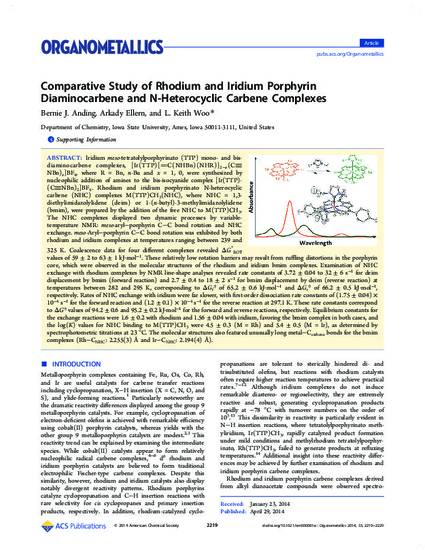
Iridium meso-tetratolylporphyrinato (TTP) mono- and bis-diaminocarbene complexes, [Ir(TTP)[═C(NHBn)(NHR)]2–x(C≡NBn)x]BF4, where R = Bn, n-Bu and x = 1, 0, were synthesized by nucleophilic addition of amines to the bis-isocyanide complex [Ir(TTP)(C≡NBn)2]BF4. Rhodium and iridium porphyrinato N-heterocyclic carbene (NHC) complexes M(TTP)CH3(NHC), where NHC = 1,3-diethylimidazolylidene (deim) or 1-(n-butyl)-3-methylimidazolylidene (bmim), were prepared by the addition of the free NHC to M(TTP)CH3. The NHC complexes displayed two dynamic processes by variable-temperature NMR: meso-aryl–porphyrin C–C bond rotation and NHC exchange. meso-Aryl–porphyrin C–C bond rotation was exhibited by both rhodium and iridium complexes at temperatures ranging between 239 and 325 K. Coalescence data for four different complexes revealed ΔG⧧ROT values of 59 ± 2 to 63 ± 1 kJ·mol–1. These relatively low rotation barriers may result from ruffling distortions in the porphyrin core, which were observed in the molecular structures of the rhodium and iridium bmim complexes. Examination of NHC exchange with rhodium complexes by NMR line-shape analyses revealed rate constants of 3.72 ± 0.04 to 32 ± 6 s–1 for deim displacement by bmim (forward reaction) and 2.7 ± 0.4 to 18 ± 2 s–1 for bmim displacement by deim (reverse reaction) at temperatures between 282 and 295 K, corresponding to ΔGf⧧ of 65.2 ± 0.6 kJ·mol–1 and ΔGr⧧ of 66.2 ± 0.5 kJ·mol–1, respectively. Rates of NHC exchange with iridium were far slower, with first-order dissociation rate constants of (1.75 ± 0.04) × 10–4 s–1 for the forward reaction and (1.2 ± 0.1) × 10–4 s–1 for the reverse reaction at 297.1 K. These rate constants correspond to ΔG⧧ values of 94.2 ± 0.6 and 95.2 ± 0.2 kJ·mol–1 for the forward and reverse reactions, respectively. Equilibrium constants for the exchange reactions were 1.6 ± 0.2 with rhodium and 1.56 ± 0.04 with iridium, favoring the bmim complex in both cases, and the log(K) values for NHC binding to M(TTP)CH3 were 4.5 ± 0.3 (M = Rh) and 5.4 ± 0.5 (M = Ir), as determined by spectrophotometric titrations at 23 °C. The molecular structures also featured unusually long metal–Ccarbene bonds for the bmim complexes (Rh–CNHC: 2.255(3) Å and Ir–CNHC: 2.194(4) Å).
Available at: http://works.bepress.com/l-woo/14/

Reprinted (adapted) with permission from Organometallics 33 (2014): 2219, doi:10.1021/om500081w. Copyright 2014 American Chemical Society.